Dungeness Crab Recipe is a South Indian hearty curry made with tamarind, tomatoes, and homemade seafood curry powder. There are several versions of crab curry that reflect each region in India, let alone each state. The unique nuances in flavor are evocative of certain regional choices of ingredients in South India.
The San Francisco Bay Area is famous for its Dungeness crab. Generally, the crab season begins before Thanksgiving, but it varies based on several factors, including the migratory habits of whales and sea turtles. Notwithstanding, the recipe below can be used on a variety of crabs, including the common blue crab.
Varieties of crab:
There are many varieties of crab, and they vary by geography and seasonality. However, the most commonly cooked crabs are the blue crab, the Dungeness crab, the horseshoe crab, the king crab, the peekytoe crab, the rock crab or snow crab, and the stone crab.
My own research indicates that the king crab contains the most meat, followed by the snow crab, Dungeness crab, and blue crab. The king crab is also called the Alaskan crab, the Japanese crab, and the Russian crab. While it can reach up to 10 feet and weigh 25 pounds, bear in mind, that generally the legs and claws contain the most meat.
The most common reason why people do not cook whole crabs is the amount of work it takes to both clean and eat them. In Singapore and Malaysia, home to the world-famous chili and pepper crabs, eating crab is a time-consuming, messy activity, and yet quite an enjoyable community event. For instance, Langkawi is particularly famous for its chili crabs by the beach. The balmy evenings cooled by sea breezes in tropical countries are perfect for enjoying this succulent delicacy, accompanied by mantou (steamed bun). So, you should not be surprised by the sight of perspiring parties wearing throwaway T-shirts and bibs, laughing and taking pictures when consuming this communal dish. I honestly cannot think of an “elegant” way to eat whole crabs ~ believe me, I have tried.
Dungeness crab:
I purchase live Dungeness crab from our local Asian markets. Usually, the butcher is always willing to put his gloved hand into the crab tank and pick out the ones of my choice. I typically choose the ones that are most active and have a big pedipalp, which I believe is indicative of the crab being fleshy. After I pick my crabs, the butcher weighs them and then cracks open the apron and the outer carapaces. My butcher then removes the gills and the mandible and then rinses the crab by removing the guts and assorted viscera.
These Dungeness crabs tend to be over 6 ¼ inches long. To make curried crab, I usually have them quarter the crab. However, there are times when I buy them fresh and cut and clean them myself just before preparing the curry. It is not much of a chore if you get the hang of it. I have included pictures and instructions on how to clean the Dungeness crabs. It is the same method for other crabs like the blue or mud crabs, if you’d care to give it a whirl.
Cleaning the crab reminds me of my childhood days when my mom would clean the crabs for her cook to prepare. I have seen my mom do this so effortlessly. My grandmother would help with the spice mixture. The aroma of this preparation would permeate the whole house, tingling my tongue to get a taste of the fresh crab meat.
Growing up on the coastal city of Chennai (formerly Madras) in South India, I am no stranger to crabs. I have been eating crab for as long as I can remember. With almost 6000 kilometers of coastline, Indian crab dishes are pervasive. Virtually every coastal village and town has crab dishes that reflect the local ingredients available to them.
This specific Dungeness crab recipe is my variation of an heirloom recipe, one that has been passed down for generations. This hearty curry is infused with tamarind, tomatoes, and my specific blend of spices that I have made into a seafood-inclined curry powder. You can make this curry powder and use for fish, prawns, lobsters, or crab.
As always, I try and heighten the flavor of my dishes. I think that making a freshly ground spice mix reflects your own flavor profile and comfort. If you don’t have time, you can purchase commercially made fish curry powder, which has a different profile than one for meat or vegetables.
In fact, Dungeness crabs are specific to the West Coast of North America. They are not common or usually available in Asia. In Tamil Nadu or Singapore, we generally use the blue crab or the mud crab, which can be flaky and tender. So, when family visits us in the US, the Dungeness crab is invariably on the menu and is usually the star of the visit.
My father always enjoys walking to the nearby Ranch Market to buy some Dungeness crabs for all of us. This is something he has done on his second day of every visit here. When I go to India or Singapore to visit them, someone usually recalls this dish with relish. Such is the allure of this crab.
I recall on a cruise trip to Alaska, we searched for “fresh” Alaskan crabs. None to be found. When we returned to Seattle, we tried Pike’s Market where we only found frozen ones. We were so disappointed. It became clear to us that fresh Alaskan crab claws are hard to find even in Alaska!
I make more than 25 varieties of crab, mostly incorporating Asian styles. Crab dishes are incredibly versatile. You can bake them, cook them in sauce, barbeque or grill them, or just sauté them. Each method has its own charm and flavors. There is a lot of potential for you to put your own stamp of authenticity to the recipes. If you visit or live in the Bay Area, making Dungeness crabs using this recipe is worth every penny.
I would like to share this Dungeness crab recipe that morphed over time into a truly crave-worthy dish! They are deeply satisfying compared to the regular blue crabs. They are definitely worthy of a spot on the dinner table at celebratory occasions such as birthdays or anniversaries.
How to clean the Dungeness crabs:
- After running the knife through the center of the crab to kill it, use the sharp tip of the knife to loosen the outer shell from the small v-tip.
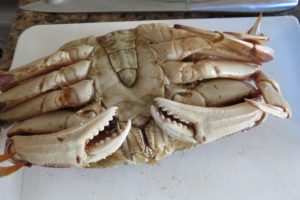
2. Remove the outer shell using the knife and turning the crab over.
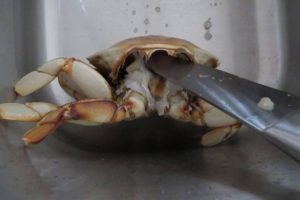
3. Clean the innards, the yellow goo inside the crab. Remove the “guts” and the feathery cone-like gills that are not edible.
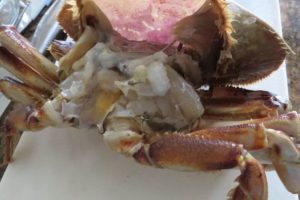
4. The crab’s white meat should look clean. Cut the body of the crab into four pieces. Wash thoroughly and drain.

You could try making my Pepper Cumin Rasam to be had after you serve the the Dungeness crab made using the South Indian recipe. Rasam helps with digestion, so you could make it for a complete authentic South Indian meal with rice and for dessert, make Kesar Pista Kulfi.
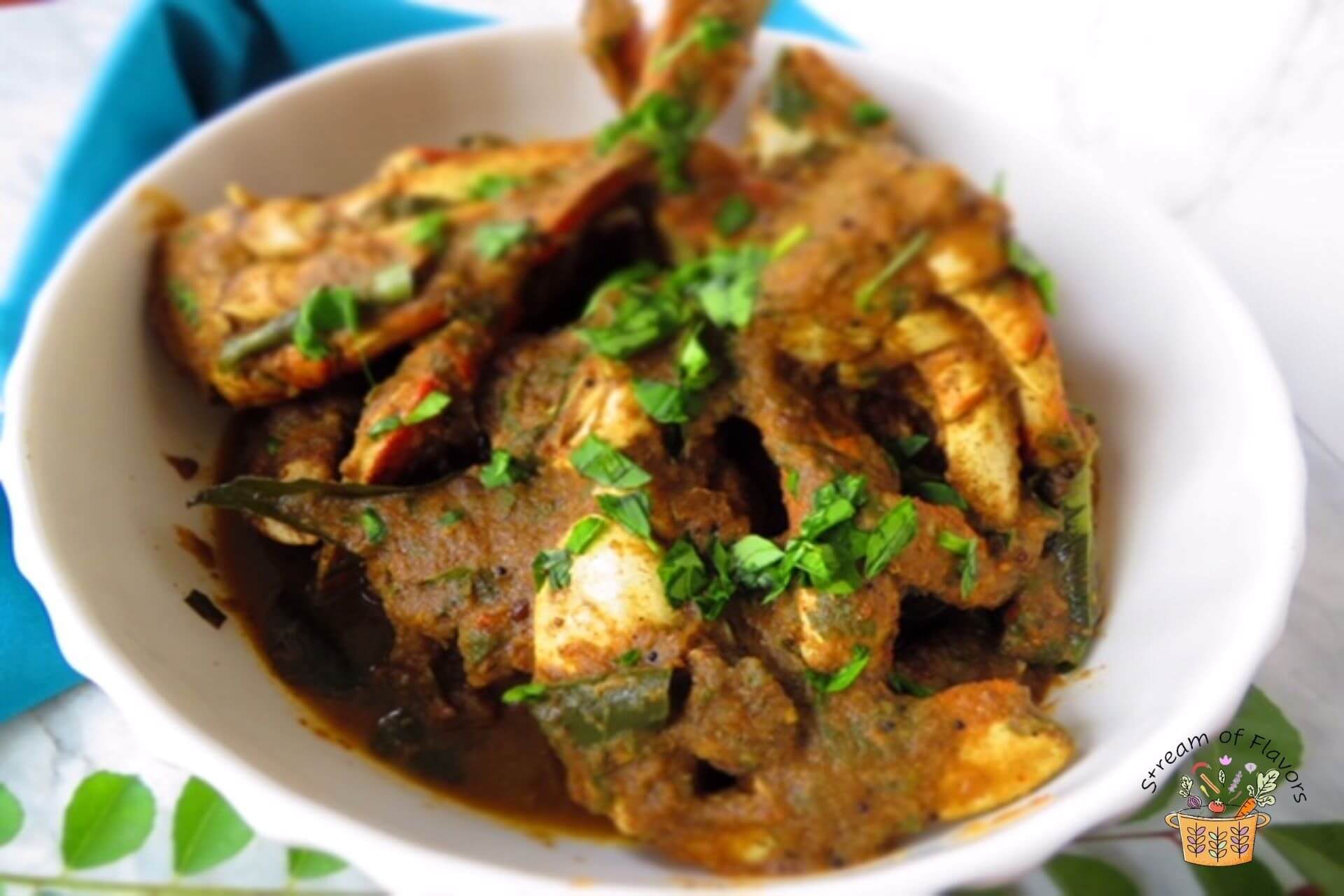
How to make the Dungeness Crab using the South Indian curry recipe:
- How to make the seafood curry powder:
- How to make the seasoning:
- How to make the Dungeness Crab curry:
1. How to make the seafood curry powder:
- Put the spices for the seafood curry powder on a pan and heat for two minutes stirring constantly. Do not let the spices burn but just smoke a little.
- Cool the spices and grind them to a fine powder. Add desired quantity of the powder to the crab curry. Cook for another 15 minutes on medium heat. Use as needed and store the rest in a airtight bottle.
2. How to make the tempering:
- Season the pan with 1 tablespoon of sesame oil. Add mustard seeds and wait for the mustard to splutter on medium heat. Add the fenugreek seeds, and turn off the heat. Now, add the curry leaves to bring out the flavor and aroma. Keep aside.
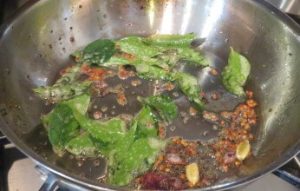
3. How to make the Dungeness crab curry (South Indian recipe):
- Clean the crab well (see pictures above) until the flesh looks white without the yellow or gray goo. Rub some salt and turmeric powder and set aside.
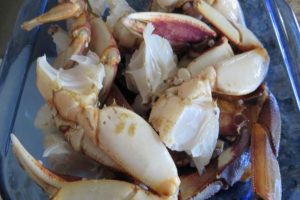
- In a cast iron Indian kadai (similar to a wok) or heavy bottomed pan, add a 1 tablespoon of Indian sesame oil and caramelize the chopped onions until golden brown.
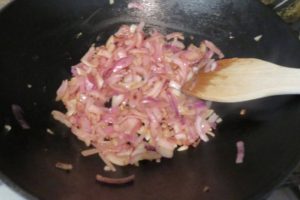
- Add the chopped tomatoes and sauté until the tomatoes become mushy. Add the ginger and garlic and cilantro and sauté for two minutes. Let it cool, and then pulverize to a smooth paste using a little water.
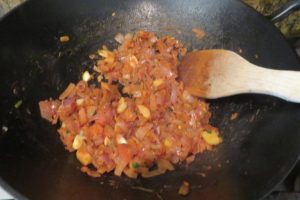
- Add the onion-tomato paste back into the kadai. Add the crab, chili powder, and the strained tamarind pulp. Add enough water to submerge the crab. Let it cook for 15 minutes by covering the kadai with a lid.
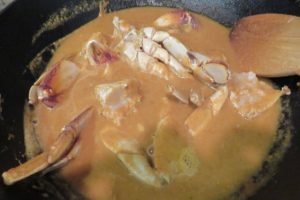
- Add the seafood curry powder and fenugreek leaves. Adjust the salt and curry powder to your desired spiciness. Cook for another 10 minutes. Add the seasoning and garnish with chopped fenugreek leaves. Serve hot with rice.
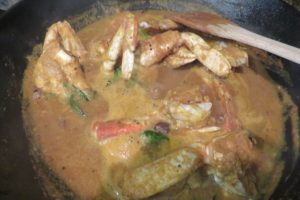
How to serve the Dungeness Crab using my recipe:
Curry is generally served with cooked rice. In South India, crab curry is served as the main course along with rice. The curry is mixed into the rice and the crab is eaten by scooping out the meat and using our mouth to crack them open. The tender claws are chewed as they are loaded with calcium. It is an art to learn how to eat crab, especially given that I grew up near the beach. Fresh seafood varieties are part of our every day menu.
The body of the crab can be tackled using your fingers to dexterously pinch out the flesh. The main claw would call for the use of a crab cracker, although you could use your teeth to crack them. Admittedly, eating crab takes a long time from start to finish. The fun part of it is eating with your family for Sunday lunch at the dinner table, sharing stories and enjoying every morsel of this delicious crab curry.
- While cleaning the crabs, I like to remove the sharp parts of the claws because I did not want them to poke my children while eating.
- It is generally a good idea to crack the shells of the crab so that the spices will seep in to give a more flavorful crab meat.
- Cast iron kadai or wok is ideal to Indian curries. The iron adds flavor to the curry. You could use a Dutch oven instead of the cast iron wok.
- Crabs must be cooked after purchase as they tend to lose their flavor and some of the meat if kept frozen for long.
Dungeness Crab Recipe
Equipment
- Cast iron kadai (wok)
Ingredients
For the seafood curry powder:
- 1 tbsp black peppercorns
- 1 tbsp coriander seeds
- 1 tbsp sesame seeds white, hulled
- 2 tsp fennel seeds
- 1 tbsp cumin seeds
- ¼ tsp turmeric powder
- ½ stick cinnamon
- 2 cloves
- ½ tsp salt to taste
For the tempering:
- 1 tsp mustard seeds
- ½ tsp fenugreek seeds
- 2 sprigs curry leaves
- 1 star anise
- 2 green cardamom pods
- 1 black cardamom pod
For the Dungeness Crab Curry:
- 2 big Dungeness crabs
- 4 red onions sliced
- 2 big tomato chopped
- 2 tbsp wet, seedless tamarind soaked in 3 cups of water
- 1 bunch fenugreek leaves without the stalks
- 1 tbsp ginger chopped
- 6 cloves garlic peeled
- 1 tsp Kashmiri chili powder
- 1 tsp salt to taste
- 3 sprigs cilantro chopped
Instructions
How to make the seafood curry powder:
- Put the spices for the seafood curry powder on a pan and heat for two minutes stirring constantly. Do not let the spices burn but just smoke a little.
- Cool the spices and grind them to a fine powder. Add desired quantity of the powder to the crab curry. Cook for another 15 minutes on medium heat.
How to make the tempering:
- Season the pan with 1 tbsp of sesame oil. Add mustard seeds and wait for the mustard to splutter on medium heat. Add the fenugreek seeds, and turn off the heat. Now, add the curry leaves to bring out the flavor and aroma.
How to make the Dungeness Crab- South Indian curry recipe:
- Clean the crab well (see pictures above) until the flesh looks white without the yellow or gray goo or gills. Rub some salt and turmeric powder and set aside.
- In a cast iron Indian kadai (similar to a wok) or heavy bottomed pan, add a 1 tbsp of Indian sesame oil and caramelize the chopped onions until golden brown.
- Add the chopped tomatoes and sauté until the tomatoes become mushy. Add the ginger, garlic, and cilantro and sauté for two minutes. Let it cool, and then pulverize to a smooth paste using a little water.
- Add the onion-tomato paste back into the kadai. Add the crab, chili powder, and the strained tamarind water. Add enough water to submerge the crabs. Let it cook for 15 minutes by covering the kadai with a lid.
- Add the seafood curry powder and fenugreek leaves. Adjust the salt and curry powder to your desired spiciness. Cook for another 10 minutes and add the seasoning and garnish with chopped fenugreek leaves.
Notes
Nutrition


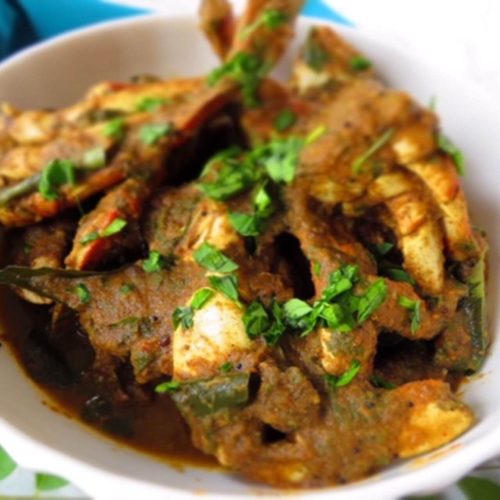




















Crab recipes are typically very complicated, but you have done extremely well in explaining this Kanchan! I will keep this recipe for special occasions! Thank you!
I am happy that the instructions to make crab worked out for you, Ishani!
Thanks for sharing!!
Lakshmi, you are welcome! I am glad you liked it.
Being a Bay Area native, I’m always looking for new ways of cooking Dungeness crab and I tried and loved it. I’m also thankful that you showed us how to clean the crab and prepare this dish. The curry was amazing especially with the cold weather.
Thank you very much for the nice comment!